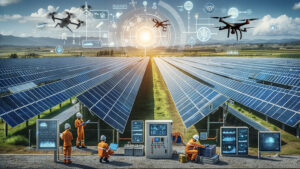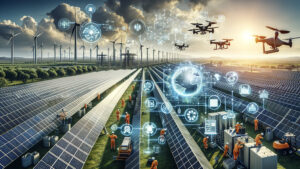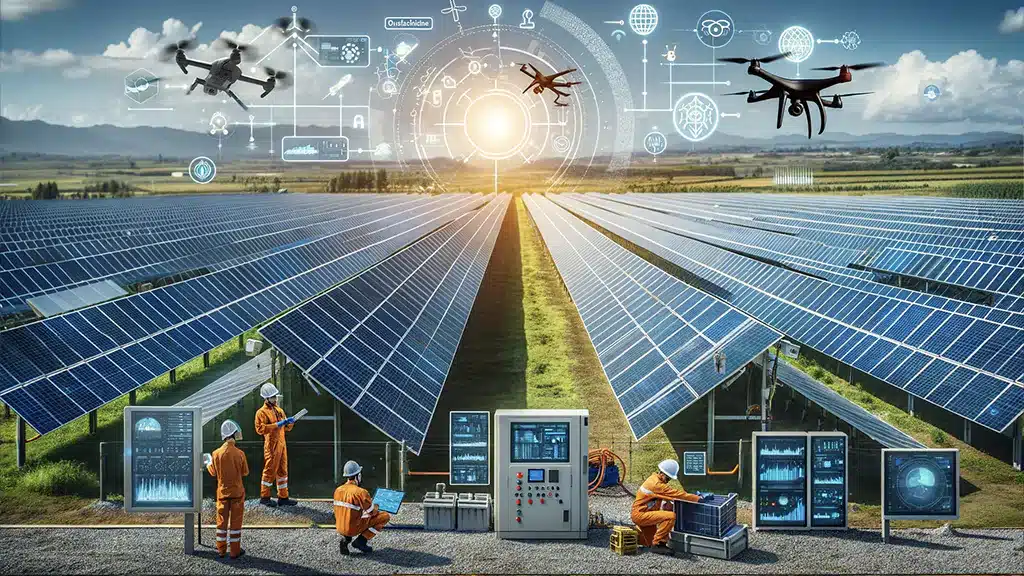 Photovoltaic farms are one of the most important sources of renewable energy (RES) in the world. However, to ensure their high efficiency and reliability, regular and efficient servicing is essential. In this respect, we can already rely on several innovative technologies that can make the servicing process of photovoltaic farms and wind farms easier and more efficient
Photovoltaic farms are one of the most important sources of renewable energy (RES) in the world. However, to ensure their high efficiency and reliability, regular and efficient servicing is essential. In this respect, we can already rely on several innovative technologies that can make the servicing process of photovoltaic farms and wind farms easier and more efficient
Drones
Drones can be used to inspect and monitor the condition of solar panels from the air. This can quickly detect and locate damage, dirt or thermal anomalies that may affect the performance of the farm. Drones can also perform simple maintenance tasks, such as cleaning the panels with compressed air or water.
Robots
Robots can be used to automatically service solar panels on the ground. Robots can move around the farm using special rails or wheels and perform tasks such as cleaning, repairing or replacing panels. The robots can also communicate with each other and with a central management system to optimise the servicing process and report on progress.
Artificial intelligence
Artificial intelligence (AI) can be used to analyse data collected by drones and robots to improve the efficiency and quality of PV farm servicing. AI can help identify problems, predict failures, plan servicing schedules, optimise energy and resource consumption, and make real-time decisions.
Innovations in photovoltaic farm service and EMACS system
 These three technologies represent promising solutions for the future of PV farm servicing. However, what measurably translates into better RES facilities is their efficient management. For this purpose, systems such as EMACS are used to manage energy facilities such as photovoltaic, hybrid or biogas farms. EMACS combines the advantages of a classic SCADA system, which enables the monitoring and control of processes related to the generation, storage and use of energy from renewable sources, with the functionalities of a business analysis system that allows the optimisation of the efficiency, costs and profits of energy assets. The EMACS system is based on the EMACS platform, which is the first Polish tool to combine these two functions. The EMACS system is available as a service to the energy industry, which includes not only the delivery and implementation of the system, but also the support of specialists in the selection of solutions, interpretation of data and advice in decisions related to the expansion and regulation of energy assets. The EMACS system also complies with the latest network requirements and safety standards. The EMACS system is a solution developed by the experts of Electrum Solutions, a company belonging to the Electrum Group, which is a leader in the field of renewable energy sources in Poland.
These three technologies represent promising solutions for the future of PV farm servicing. However, what measurably translates into better RES facilities is their efficient management. For this purpose, systems such as EMACS are used to manage energy facilities such as photovoltaic, hybrid or biogas farms. EMACS combines the advantages of a classic SCADA system, which enables the monitoring and control of processes related to the generation, storage and use of energy from renewable sources, with the functionalities of a business analysis system that allows the optimisation of the efficiency, costs and profits of energy assets. The EMACS system is based on the EMACS platform, which is the first Polish tool to combine these two functions. The EMACS system is available as a service to the energy industry, which includes not only the delivery and implementation of the system, but also the support of specialists in the selection of solutions, interpretation of data and advice in decisions related to the expansion and regulation of energy assets. The EMACS system also complies with the latest network requirements and safety standards. The EMACS system is a solution developed by the experts of Electrum Solutions, a company belonging to the Electrum Group, which is a leader in the field of renewable energy sources in Poland.

